#university of guelph
Text
Blog 3
The idea of privilege is significant yet often overlooked in the fields of environmental research and nature interpretation. To define privilege, I would suggest it is a complicated combination of unfair advantages that people may accumulate during their lives. It covers a wide range of social benefits, frequently categorized by country, race, gender, socioeconomic background, and level of education.The understanding of nature is not exempt from the effects of privilege. It has a big impact on the stories we tell about the natural world and who gets to have a say in them. There is an uneven distribution of access to natural areas. Many people are unable to take advantage of the peace and educational possibilities that nature offers due to geographical and economic constraints. For example, those who live in urban or low-income neighborhoods have a difficult time getting to green spaces since they are frequently few or ones too distant from their homes. The feeling of safety and belonging in nature extends well beyond easy access. Another factor such as a person's degree of education frequently determines how deeply they connect with their surroundings. Higher education, especially in environmental science-related fields, gives people the skills necessary to analyze ecological phenomena, comprehend conservation issues, and participate in academic discussions. This is a privilege that can improve one's advocacy for and appreciation of nature, but it is not available to everyone.
When I consider my personal experiences, I see how my privileges influence how I engage with the natural world. Since I am physically able to, I can walk through harsh terrain that would be impassable for someone with a physical disability. Given my training in environmental science, I would also be able to understand the complexities of ecosystems, which makes spending time in nature both a spiritual and intellectual experience. Being fluent in English gives me the opportunities to express my opinions and access a wide range of scientific material, which deepens my comprehension and makes it possible for me to take part in international discussions regarding conservation. The goal of acknowledging these benefits is to raise awareness of the discrepancies that exist. Those of us who work in the field of nature interpretation have a responsibility to utilize our privilege to promote diversity and close inequalities in society. This means appreciating the ecological wisdom of all cultures, establishing venues where a range of views are acknowledged and heard, and providing fair access to natural regions. Adopting this kind of inclusion enhances environmental research as a whole and makes it possible for a larger community to enjoy and share nature's advantages and beauty.
To summarise, while we investigate the natural world and our position within it, we must constantly reflect. By doing this, we may work to lower the obstacles that stand in the way of people enjoying nature's beauty and make sure that our perceptions of the surrounding landscape are as varied and complex as the ecosystems we study. This understanding is the first step towards an interpretation of nature that is more just and equal and that honours all viewpoints and experiences.
5 notes
·
View notes
Text
What do I bring as an Interpreter?
Some beliefs I may bring to the table...
One thing I have been effortlessly passionate about is conservation and ending extinction. In the textbook by Knudson et al. (2018), interpreters are required to have "depth in both subject matter and delivery skills". With this being said, passion plays a huge role in conveying information in a manner that teaches but also engages learners. I feel my passion for the natural world helps to enhance my want to teach my own interpretations. I believe every living thing plays a large role in this world, whether it be local or worldwide, and with species going endangered and then extinct we lose biodiversity and a role that that species played in the world. For example, we all know the dangers of honey bee declines as proven in many articles such as that by M.E. Watanabe in 1994 which covers the previous and growing fears of honey bee decline on farmers crops and the high demand for said crops. I couldn't agree more that the decline in honey bee populations due to many factors is causing a huge issue in our high demand for crops. Among this, I have a huge passion for the decline in lions in the world due to poaching which is highlighted in an article by Becker et al. (2012), which covers the decline in male lions in Zambia of approximately 30% over two decades due to trophy-hunting by poaching. While this may not be a world-wide issue, the decline in lion population poses a very large threat to biodiversity within Africa and other animals that habituate the land. This is just a small portion of decline in biodiversity in our world that I feel needs to be taught and I feel that my passion for maintaining wild animal populations is something that I can gladly bring forth in interpreting nature and teaching this. Below is just a sample of one of my paintings to try and bring awareness to the beauty of male lions and the horrible truth about poaching and caged hunts within Africa.

Responsibilities I have as an interpreter...
This prompt rather stumped me at first as I never considered what responsibilities I personally have as a nature interpreter. Upon reading the provided article by Rodenburg (2019), I felt a connection with teaching young minds by promoting curiosity, as kids are driven by curiosity. While I'm not a huge fan of children myself, interpretation seems to stem from a young mind by encouraging questions driven by curiosity and using anything as a teachable moment. By encouraging children to ask questions about the natural world and making this exciting, nature interpreters can stem from just about anywhere. From there, like myself, children can learn their own passions for interpretation and from there continue to share with family and friends. I feel that I share this responsibility to teach colleagues and perhaps young children in my own life such as nephews and nieces about the wonders of the world and how we can help it. I feel this stemmed from learning from my uncle as a child, as stated in my first blog post. My uncle created an exciting learning environment in the natural world and encouraged me to ask questions and always have an open and curious mind. I can only hope to share this with my peers, colleagues, and potentially young minds that I have the opportunity to teach.
What now?
My biggest question moving forward is how I can use what I already know and what I have now learned through this course. Will I teach this in a school setting? A more natural setting such as a campsite? Or will I use my interpretation of nature and connect it to our every day world? Will I continue to paint and draw animals that I feel need vast attention and interpret nature in that sense? Being a soft spoken person, I feel like I will always revert to the latter and share my voice in an artistic manner. In the textbook by Knudson et al. (2018), it is mentioned in chapter 10 that 'Artists of the 19th century created paintings that convinced Congress to set aside wilderness landscapes to protect them from future generations'. This is inspiring to me as I know art has been used to capture wildlife and its beauty for many decades and I can only hope that my art can do the same. By creating paintings and drawings that interpret what I see and how I feel, I can only hope to capture the attention of a handful of young and/or wise minds and create a positive change for our future whether that be through conservation or continued education.
I can only hope that these blog posts alone potentially reach some minds and inspire them to interpret and conserve our world. Until then, happy interpreting.
References
Knudson, L.B., Ted, T.C., Douglas, M. Interpreting Cultural and Natural Heritage: For a Better World. Available from: Sagamore Publishing LLC, Sagamore Publishing LLC, 2018
Watanabe, M. E. (1994). Pollination worries rise as honey bees decline. Science, 265(5176), 1170. https://link-gale-com.subzero.lib.uoguelph.ca/apps/doc/A15798932/AONE?u=guel77241&sid=bookmark-AONE&xid=ac077013
Becker, M. S., Watson, F. G. R., Droge, E., Leigh, K., Carlson, R. S., & Carlson, A. A. (2012). Estimating past and future male loss in three Zambian lion populations. The Journal of Wildlife Management, 77(1), 128–142. https://doi.org/10.1002/jwmg.446
Rodenburg, J. (2019). Why Environmental Educators Shouldn't Give Up Hope. Clearing. Available from: https://clearingmagazine.org/archives/14300
2 notes
·
View notes
Video
youtube
NOAH23 - TRAP IN GUELPH
#noah23#guelph#rap#trap in guelph#drill#trap#hip hop#canadian hip hop#guelph ontario canada#nighthawks#gryphons#university of guelph
0 notes
Text
The Greenhorn Chronicles 30: Sean Jobin on Personal Story, Work, and Views in Show Jumping
The Greenhorn Chronicles 30: Sean Jobin on Personal Story, Work, and Views in Show Jumping
Publisher: In-Sight Publishing
Publisher Founding: December 1, 2014
Web Domain: http://www.in-sightpublishing.com
Location: Fort Langley, Township of Langley, British Columbia, Canada
Journal: In-Sight: Independent Interview-Based Journal
Journal Founding: August 2, 2012
Frequency: Three (3) Times Per Year
Review Status: Non-Peer-Reviewed
Access: Electronic/Digital & Open…

View On WordPress
#Double Clear LLC#Emily Rickert#Eric Lamaze#FEI#Grand Prix rider#Hickstead#Hugh Graham#Major League#Mike Grinyer#Sean Jobin#University of Guelph
0 notes
Text
ART CLASSES WITHOUT PAIN: ASHLEYNITKIN.WORDPRESS.COM
ONLINE EVERYWHERE AND IN-PERSON CLASSES IN THE GREATER TORONTO AREA. SPECIALIZING IN DRAWING.

#artists on tumblr#ocadu#ryerson university#universities#guelph university#georgebrowncollege#brock university#teaching things#teaching tag#art workshops#art classes#seniorspace#seniorcare#women in art#beautiful women#woman#world#language learning#arts & crafts#artwork#illustration#beginner artist#anime art#animation#anime fanart#mixed media#photographers on tumblr#women photographers#female photographers
3 notes
·
View notes
Text
nobody suffers more than those of us who grew up in cities with big universities like it’s a college town TO YOU i live here all the time. now pipe down i have work in the morning
#i’m sure it’s worse if it’s a smaller city that’s more reliant on the university for its economy#like sorry to anyone who lives in guelph lmao#soapbox
12 notes
·
View notes
Text
Facilities Inside Accommodations
Facilities Inside Complexes
Rent of the Accommodation
Stay Duration
Distance from the Institute
Security Features
0 notes
Text
Blog 6: Unpacking Edward Hyams Quote
With the following thought-provoking quote from the book "The Gifts of Interpretation", Edward Hyams makes a strong case for the importance of history and the necessity of integrity. "There is no peculiar merit in ancient things, but there is merit in integrity, and integrity entails the keeping together of the parts of any whole, and if these parts are scattered throughout time, then the maintenance of integrity entails a knowledge, a memory, of ancient things. …. To think, feel or act as though the past is done with, is equivalent to believing that a railway station through which our train has just passed, only existed for as long as our train was in it." To fully grasp the significance of this verse, which is full of implications and meaning, it is worth delving further.
Hyams begins by refuting the idea that objects that are ancient are valuable just because of their age. Rather, he turns the emphasis to integrity, characterizing it as a structural need that sustains the many constituents of any organism across time, as well as a moral virtue. In this sense, integrity encompasses not just personal qualities but also the collective consciousness and knowledge of the community as a whole. It follows that society's integrity is maintained by ongoing, shared remembrance and comprehension of its history.
The comparison of a train station perfectly captures the spirit of Hyams' argument. The past does not become irrelevant as time goes on, just as a train station does not vanish the instant a train leaves. It is a misperception of time and existence to think that history is meaningless once it has been lived. History is a continuum that both shapes and is shaped by the present, not a collection of discrete occurrences. Our comprehension of the present is shaped by the past, which also directs our future course of action. This perspective challenges us to reevaluate how we relate to the past. It implies that a society's integrity is preserved by its capacity to recall, comprehend, and incorporate its past into its current identity in addition to its outward accomplishments and inventions. In order to achieve this integration, the past must be actively engaged with and acknowledged for its effect on the present and future.
The quotation from Hyams is an appeal for a more in-depth study of history as a vital component of leading an honorable life rather than just as an academic exercise. It inspires us to view history as an essential component of our shared identity rather than as a burden or an outmoded relic. We may safeguard the integrity of society and become better equipped to handle the problems of the present and the future by accepting our historical consciousness.
By dissecting Hyams' quotation, we are reminded of how important history is to maintaining social order. It pushes us to see history as a dynamic, breathing aspect of our shared identity that influences both the present and the future, rather than merely a chronicle of past occurrences. Recognising the ongoing significance of the past is crucial to preserving our society's integrity and making sure we proceed with discernment and wisdom.
References:
Beck, L., Cable, T. T., & Knudson, D. M. (2018). Interpreting cultural and natural heritage: For A Better World. Sagamore-Venture Publishing.
4 notes
·
View notes
Text
NASA Inspires Your Crafty Creations for World Embroidery Day
It’s amazing what you can do with a little needle and thread! For #WorldEmbroideryDay, we asked what NASA imagery inspired you. You responded with a variety of embroidered creations, highlighting our different areas of study.
Here’s what we found:
Webb’s Carina Nebula
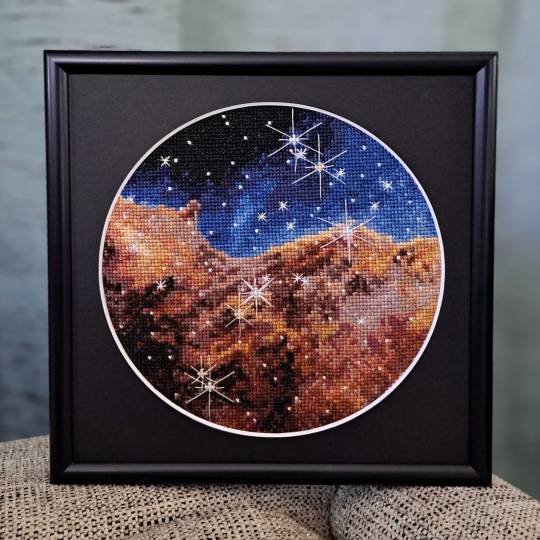
Wendy Edwards, a project coordinator with Earth Science Data Systems at NASA, created this embroidered piece inspired by Webb’s Carina Nebula image. Captured in infrared light, this image revealed for the first time previously invisible areas of star birth. Credit: Wendy Edwards, NASA. Pattern credit: Clare Bray, Climbing Goat Designs
Wendy Edwards, a project coordinator with Earth Science Data Systems at NASA, first learned cross stitch in middle school where she had to pick rotating electives and cross stitch/embroidery was one of the options. “When I look up to the stars and think about how incredibly, incomprehensibly big it is out there in the universe, I’m reminded that the universe isn’t ‘out there’ at all. We’re in it,” she said. Her latest piece focused on Webb’s image release of the Carina Nebula. The image showcased the telescope’s ability to peer through cosmic dust, shedding new light on how stars form.
Ocean Color Imagery: Exploring the North Caspian Sea
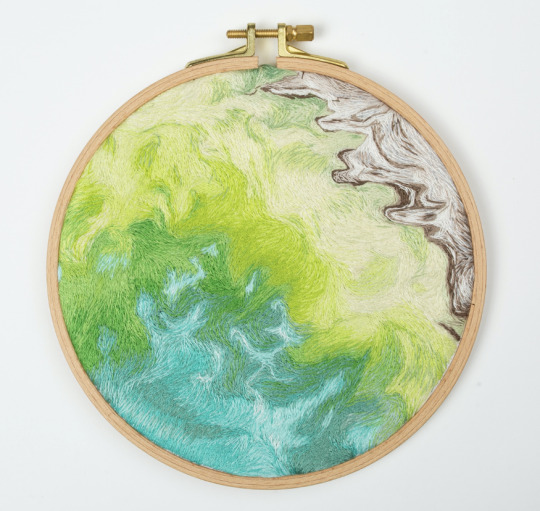
Danielle Currie of Satellite Stitches created a piece inspired by the Caspian Sea, taken by NASA’s ocean color satellites. Credit: Danielle Currie/Satellite Stitches
Danielle Currie is an environmental professional who resides in New Brunswick, Canada. She began embroidering at the beginning of the Covid-19 pandemic as a hobby to take her mind off the stress of the unknown. Danielle’s piece is titled “46.69, 50.43,” named after the coordinates of the area of the northern Caspian Sea captured by LandSat8 in 2019.

An image of the Caspian Sea captured by Landsat 8 in 2019. Credit: NASA
Two Hubble Images of the Pillars of Creation, 1995 and 2015
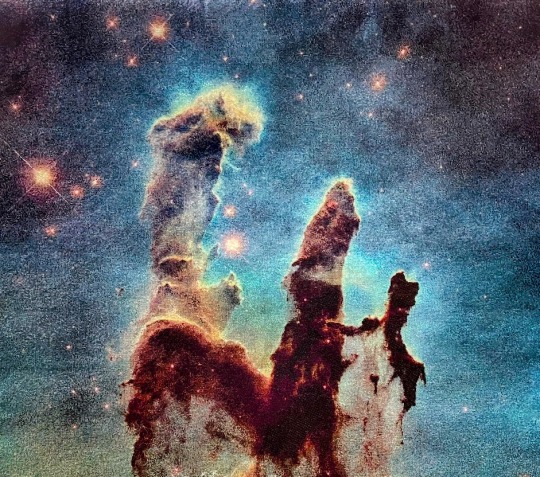
Melissa Cole of Star Stuff Stitching created an embroidery piece based on the Hubble image Pillars of Creation released in 1995. Credit: Melissa Cole, Star Stuff Stitching
Melissa Cole is an award-winning fiber artist from Philadelphia, PA, USA, inspired by the beauty and vastness of the universe. They began creating their own cross stitch patterns at 14, while living with their grandparents in rural Michigan, using colored pencils and graph paper. The Pillars of Creation (Eagle Nebula, M16), released by the Hubble Telescope in 1995 when Melissa was just 11 years old, captured the imagination of a young person in a rural, religious setting, with limited access to science education.

Lauren Wright Vartanian of the shop Neurons and Nebulas created this piece inspired by the Hubble Space Telescope’s 2015 25th anniversary re-capture of the Pillars of Creation. Credit: Lauren Wright Vartanian, Neurons and Nebulas
Lauren Wright Vartanian of Guelph, Ontario Canada considers herself a huge space nerd. She’s a multidisciplinary artist who took up hand sewing after the birth of her daughter. She’s currently working on the illustrations for a science themed alphabet book, made entirely out of textile art. It is being published by Firefly Books and comes out in the fall of 2024. Lauren said she was enamored by the original Pillars image released by Hubble in 1995. When Hubble released a higher resolution capture in 2015, she fell in love even further! This is her tribute to those well-known images.
James Webb Telescope Captures Pillars of Creation

Darci Lenker of Darci Lenker Art, created a rectangular version of Webb’s Pillars of Creation. Credit: Darci Lenker of Darci Lenker Art
Darci Lenker of Norman, Oklahoma started embroidery in college more than 20 years ago, but mainly only used it as an embellishment for her other fiber works. In 2015, she started a daily embroidery project where she planned to do one one-inch circle of embroidery every day for a year. She did a collection of miniature thread painted galaxies and nebulas for Science Museum Oklahoma in 2019. Lenker said she had previously embroidered the Hubble Telescope’s image of Pillars of Creation and was excited to see the new Webb Telescope image of the same thing. Lenker could not wait to stitch the same piece with bolder, more vivid colors.
Milky Way

Darci Lenker of Darci Lenker Art was inspired by NASA’s imaging of the Milky Way Galaxy. Credit: Darci Lenker
In this piece, Lenker became inspired by the Milky Way Galaxy, which is organized into spiral arms of giant stars that illuminate interstellar gas and dust. The Sun is in a finger called the Orion Spur.
The Cosmic Microwave Background
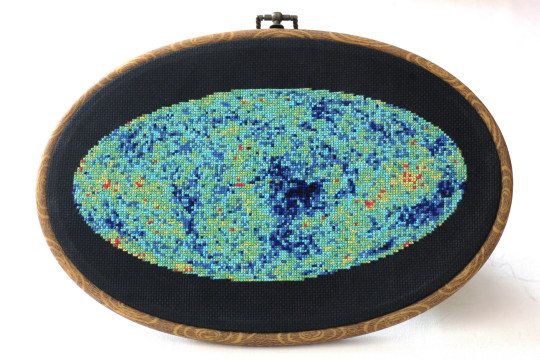
This image shows an embroidery design based on the cosmic microwave background, created by Jessica Campbell, who runs Astrostitches. Inside a tan wooden frame, a colorful oval is stitched onto a black background in shades of blue, green, yellow, and a little bit of red. Credit: Jessica Campbell/ Astrostitches
Jessica Campbell obtained her PhD in astrophysics from the University of Toronto studying interstellar dust and magnetic fields in the Milky Way Galaxy. Jessica promptly taught herself how to cross-stitch in March 2020 and has since enjoyed turning astronomical observations into realistic cross-stitches. Her piece was inspired by the cosmic microwave background, which displays the oldest light in the universe.

The full-sky image of the temperature fluctuations (shown as color differences) in the cosmic microwave background, made from nine years of WMAP observations. These are the seeds of galaxies, from a time when the universe was under 400,000 years old. Credit: NASA/WMAP Science Team
GISSTEMP: NASA’s Yearly Temperature Release

Katy Mersmann, a NASA social media specialist, created this embroidered piece based on NASA’s Goddard Institute for Space Studies (GISS) global annual temperature record. Earth’s average surface temperature in 2020 tied with 2016 as the warmest year on record. Credit: Katy Mersmann, NASA
Katy Mersmann is a social media specialist at NASA’s Goddard Space Flight Center in Greenbelt, Md. She started embroidering when she was in graduate school. Many of her pieces are inspired by her work as a communicator. With climate data in particular, she was inspired by the researchers who are doing the work to understand how the planet is changing. The GISTEMP piece above is based on a data visualization of 2020 global temperature anomalies, still currently tied for the warmest year on record.
In addition to embroidery, NASA continues to inspire art in all forms. Check out other creative takes with Landsat Crafts and the James Webb Space telescope public art gallery.
Make sure to follow us on Tumblr for your regular dose of space!
#NASA#creativity#fiber art#embroidery#art#art challenge#needlework#crafts#handmade#textile art#cross stitch#stitching#inspiration#inspo#Earth#Earth science#Hubble#James Webb Space Telescope#climate change#water#nebula#stars
6K notes
·
View notes
Photo
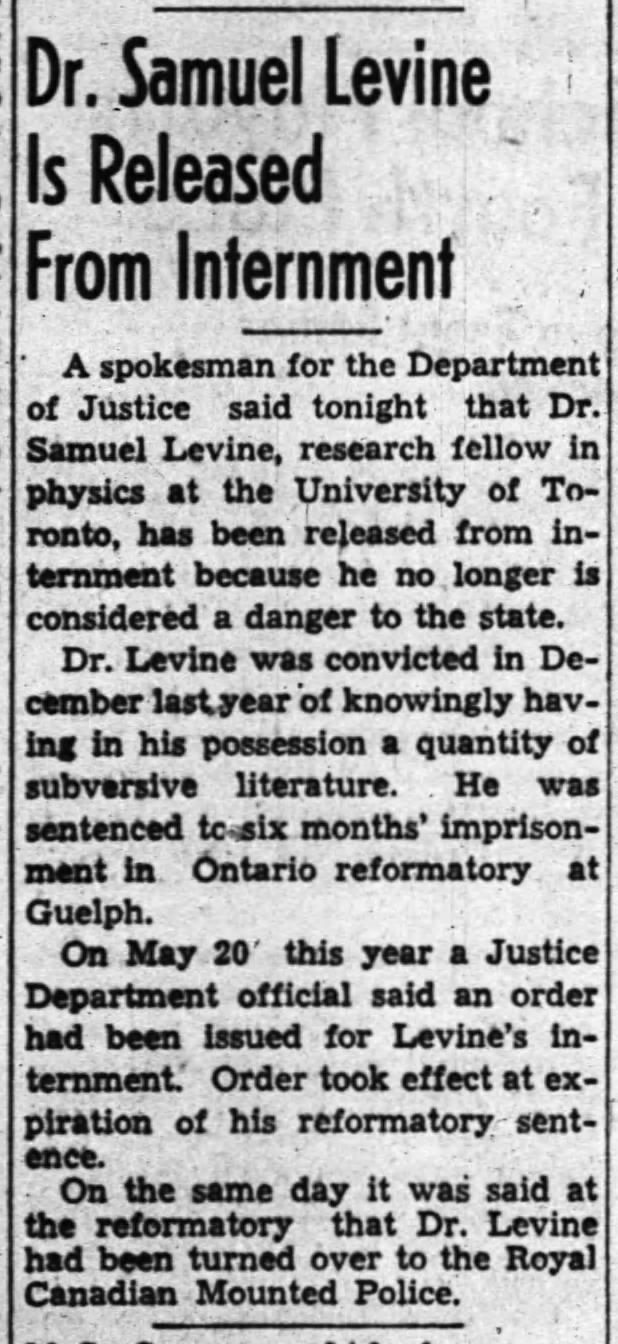
“Dr. Samuel Levine Is Released From Internment,” Ottawa Journal. October 10, 1941. Page 19.
---
A spokesman for the Department of Justice said tonight that Dr. Samuel Levine, research fellow in physics at the University of Toronto, has been released from internment because he no longer is considered a danger to the state.
Dr. Levine was convicted In December last year of knowingly having in his possession a quantity of subversive literature. He was sentenced to six months' imprisonment in Ontario reformatory at Guelph.
On May 20 this year, a Justice Department official said an order had been issued for Levine's internment. Order took effect at expiration of his reformatory sentence.
On the same day, it was said at the reformatory that Dr. Levine had been turned over to the Royal Canadian Mounted Police.
[More about Levine here. A monstrous case of injustice]
#university of toronto#university workers#released from prison#wrongfully imprisoned#war hysteria#communist party of canada#communists#anti-communism#frameup#sentenced to prison#guelph reformatory#suppression of free speech#suppression of political dissidents#defence of canada regulations#canada during world war 2#crime and punishment in canada#history of crime and punishment in canada#internment camp
0 notes
Text
Bumblebees can surprisingly withstand days underwater, according to a study published Wednesday, suggesting they could withstand increased floods brought on by climate change that threaten their winter hibernation burrows.
The survival of these pollinators that are crucial to ecosystems is "encouraging" amid worrying global trends of their declining populations, the study's lead author Sabrina Rondeau told AFP.
With global warming prompting more frequent and extreme floods in regions around the world, it poses "an unpredictable challenge for soil-dwelling species, particularly bees nesting or overwintering underground", co-author Nigel Raine of the University of Guelph said in a statement.
Rondeau said she first discovered queen bumblebees could withstand drowning by accident.
She had been studying the effect of pesticide residues in soil on queen bumblebees that burrow underground for the winter when water accidentally entered the tubes housing a few of the bees.
"I freaked out," said Rondeau, who had been conducting the experiment for her doctoral studies. "It was only a small proportion… so it was not that big of a deal, but I didn't want to lose those bees."
To her "shock", she said, they survived.
"I've been studying bumblebees for a very long time. I've talked about it to a lot of people and no one knew that this was a possibility," she said.
Continue Reading.
115 notes
·
View notes
Text
Blog #4
In the subject matter of nature interpretation, art emerges as a distinct and strong medium for bridging the gap between the physical and intangible, the visible and unseen. It takes more than just having an aptitude for painting or a degree in art history. Rather, it concerns the ways in which each of us experiences and communicates the beauty of nature via different artistic mediums. When it comes to presenting its beauty to those who seek it out, nature, in all its splendor, does not discriminate. Observation, appreciation, and communication are increasingly important aspects of our work. We serve as messengers, bringing the quiet yet powerful message of nature to a broader audience. Every aspect of nature, from the delicate structure of a leaf to the majesty of a mountain range, is bursting with passion and a tale just waiting to be revealed.
The section "Interpreting the Gift of Beauty" discussed in Chapter five of the textbook explores how nature interpretation is an art form that extends beyond traditional media like painting and sculpture, including a wide range of disciplines such as spoken word, literature, music, and photography. Every platform offers a different perspective for appreciating and conveying the beauty of nature. Photographs capture transient moments in nature, such as sunrises and sunsets, and serve as a powerful reminder of the importance of appreciating the present. Through evocative tales, poetry, and descriptive narratives, literature creates vivid mental images that carry the reader to unexplored natural settings and strengthen their emotional connection to the outdoors even in the absence of visible cues. Natural sounds and music provide an immersive auditory experience that highlights the intrinsic beauty of the natural world. These sounds range from the soft flutter of leaves to the forceful cascade of waterfalls, reflecting the symphony of the environment. Furthermore, the spoken word strengthens the audience's enjoyment of and connection to the natural world by sharing personal experiences, information, and stories through storytelling, guided walks, and interpretive speeches.
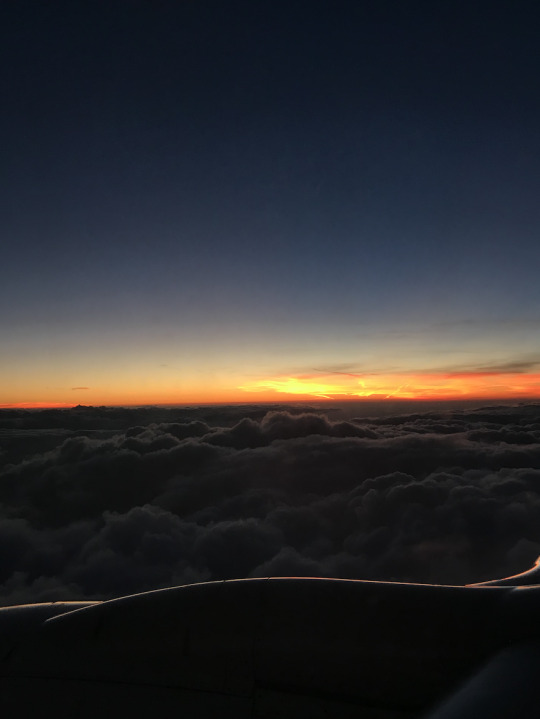
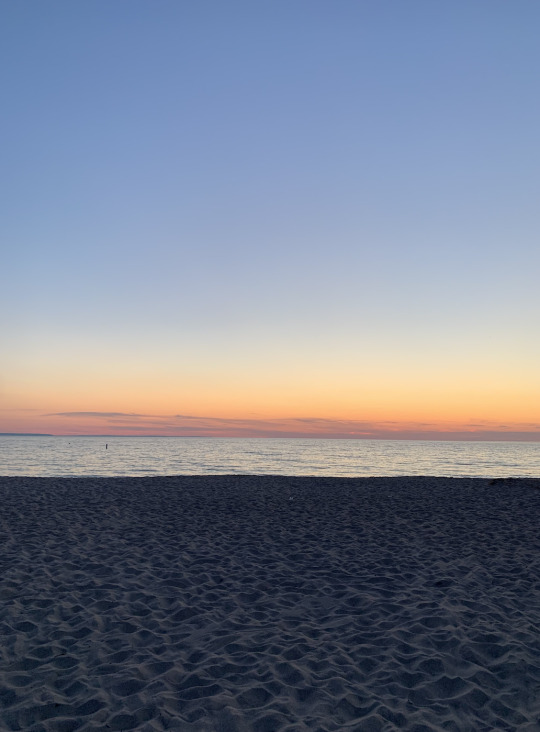
These two sunset views from very different scenes highlight nature's fleeting beauty and how it remains consistent no matter where you find it.
Interpreting nature's gift of beauty is a complex process. It entails campaigning for sustainability and conservation, recognising cultural and historical backgrounds, philosophical thought, emotional connection, and creative inspiration. Every one of these elements deepens and enriches our comprehension and admiration of the natural world.
In summary, my investigation into the field of artistic interpretation of nature reveals the complexity of this subject. It highlights the ways in which art acts as a conduit between the material and the immaterial facets of nature, enabling me to interact with it and find its beauty in a variety of ways. Whether it be via photography, writing, music, or the spoken word, each media provides a distinct perspective on the natural world. This strategy highlights the significance of sustainability and conservation while also fostering a stronger intellectual and emotional bond with the natural world. This exploration of several artistic forms serves to reinforce the importance of art in nature interpretation as a potent catalyst for raising awareness and appreciation of the environment, rather than only serving as a means of expression.
4 notes
·
View notes
Text
For the next year, this is what Alexandra Mussar will call home: a cramped bedroom with water damage and dysfunctional sinks, in a house shared with six other students. For this, she's paying $840 every month.
This isn't how she pictured her university housing experience, but after six long months hunting for somewhere to live, she says she felt she had to settle.
"There were no other options. This was my last resort," she said. "It was either that or I was couch surfing for the next year."
Across the country, students are sharing similar stories. The soaring rents that have hit some of Canada's biggest cities have also walloped college and university towns, with little relief in sight. Take Guelph, Ont., where the latest data shows the average cost for a one bedroom apartment has spiked to $2,095 per month in June, up 27 per cent from the same time last year. [...]
Continue Reading.
Tagging: @politicsofcanada, @vague-humanoid
338 notes
·
View notes
Note
do you know a lot of canadian universities? like brock, mcmaster, guelph?
Yes??? I… live … here?????
29 notes
·
View notes
Text
Fairly hyperventilating this fine Sunday afternoon. The L.M. Montgomery Institute continues to bring my soul unfettered joy awareness to access to ‘additive’ books about Maud’s work, and I’m ‘thrilling all over’ to get my hands on this one:
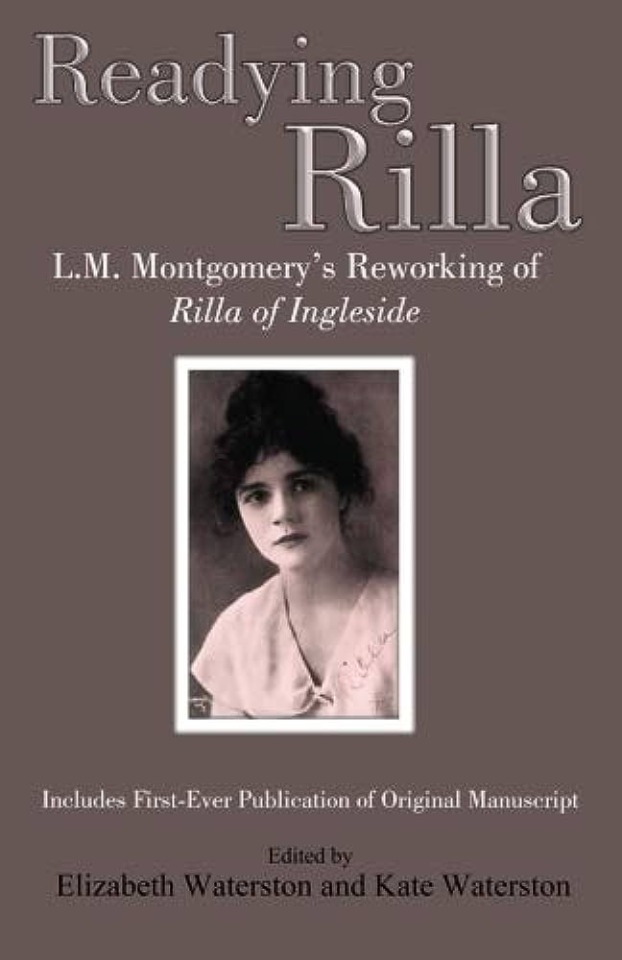
ORIGINAL manuscript, you say? The one that was an untrimmed 518 pages long???? And so I checked the description:
“Rilla of Ingleside, L.M. Montgomery’s 1921 novel about the Canadian home-front during World War I, is both moving and at times very funny. Montgomery’s original handwritten manuscript of 518 pages, along with 71 pages of notes, survives today, housed at the University of Guelph. The manuscript has been painstakingly rendered in a readable format by Kate Waterston, and is available here, with an introduction by Montgomery expert Elizabeth Waterston. This edition enables us to witness the process of Montgomery’s literary refinement as she edited her own work.” READYING RILLA
I wonder if the University of Guelph will let you just touch something (anything!) of Mauds, if you ask nicely enough!
Additionally, Elizabeth H. Waterson is a sweet little angel of a Scholar, with as much love in her her heart for Maud and Mauds work as one can possibly fit in, and she recently celebrated her 101st birthday!
In case anyone else is interested, you may write to her at:
Elizabeth H. Waterston
9436 Trinity Circle
Bradenton, FL 34210
She apparently LOVES to hear from Maud fans, and I’m leaving my house in like ten minutes to go find some extra cute stationary to write her some essentially neurotic fan-mail that’ll probably leave her questioning a public address.
#am i hoping there’s some added walter content to be scared up in this manuscript?#well yeah#👀#rilla of ingleside#lucy maud montgomery#elizabeth waterson
83 notes
·
View notes
Video
youtube
This is an ex-racing dog named Nitro, captured on video in 2012 (or perhaps earlier) while playing. Like many greyhounds, he digs in the dirt, then spins, then freezes, then runs a lap, finding a way to express behaviors related to running and capturing prey--adapted to the back yard. Since the late 1980s, many tens of thousands of racing greyhounds at American tracks found too slow or injured to turn a profit were adopted by people who kept them as household companions. In the digital age, those adopters documented their dogs' behaviour in great detail by way of email lists and discussion boards, Facebook and Instagram posts, YouTube videos, iPhone photos, and other digital sources. Taken together, all those greyhound people produced an avalanche of information about the changing behaviours of greyhounds beyond the limitations of the dog track.
To historians, this is a great opportunity but also an overwhelming one. We have almost no historical records documenting the lives of historical dogs before the internet and mobile device age. Now, animal historians need to make use of these abundent but fragile sources while we can, before they are deleted from cyberspace or lost on old hard drives that end up in the e-waste recycling bin.
This video is one of the sources that inspired my latest piece, "Who is a Greyhound? Reflections on the Nonhuman Digital Archive," which appears in a new book Traces of the Animal Past: Methodological Challenges in Animal History.
visit the book at University of Calgary Press
for more of this kind of stuff see my cv
#University of Guelph#Greyhounds#Digital Historical Sources#Animal Advocacy#Dog Racing#The Track#susan nance historian
0 notes